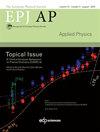Design, fabrication and characterization of an electrical-explosively actuated MEMS flyer-accelerator inserted with parallel bridge foils
IF 0.9
4区 物理与天体物理
Q4 PHYSICS, APPLIED
引用次数: 7
Abstract
Parallel bridge foils (PBF) with four strip foils, which is derived from traditional single bridge foil (SBF), was designed to study the effect of convergence and collision of plasmas and shock waves on driving flyer. Firstly, Electro-thermal simulation of PBF was performed to analyze temperature distribution before melting, which predicted the synchronous burst characteristic of PBF. Subsequently, a capacitor discharging circuit was designed to initiate bridge foils, results indicated PBF reached higher burst power in shorter time compared with SBF due to better matching between PBF and the test circuit. The flow fields of electrical explosion of bridge foils were photographed by ultra-high-speed camera, which displayed PBF almost burst simultaneously. Moreover, PBF had wider and brighter flow field visualization than SBF owing to convergence and superposition of plasma beams. Most importantly, flyer-accelerators inserted with bridge foils were prepared by MEMS technology, and comparative analysis from PDV revealed MEMS flyer-accelerator inserted with PBF had access to better velocity performances, compared with that inserted with SBF. For instance, PBF flyer-accelerator spent mere 168 ns to 2325 m/s at 900 V/0.22 µF, but SBF flyer-accelerator took 335 ns to 1073 m/s. Finally, we proposed a mathematical model for explaining the enhancement effect of flyer velocity, which to some extent showed good agreement with experimentation.插入平行桥箔的电爆炸驱动MEMS飞行加速器的设计、制造和表征
为研究等离子体与激波的汇聚和碰撞对驱动飞片的影响,设计了由传统单桥箔(SBF)演变而来的四条带平行桥箔(PBF)。首先,对PBF进行电热模拟,分析熔点前的温度分布,预测PBF的同步爆裂特性。随后,设计了电容放电电路启动桥接箔,结果表明,由于PBF与测试电路的匹配更好,PBF比SBF在更短的时间内获得更高的突发功率。利用超高速摄像机对桥膜电爆炸流场进行了拍摄,发现桥膜电爆炸流场几乎同时发生爆炸。此外,由于等离子体束的汇聚和叠加,PBF比SBF具有更宽、更亮的流场显示。最重要的是,利用MEMS技术制备了插入桥膜的飞行加速器,并通过PDV进行了对比分析,结果表明,与插入SBF相比,插入PBF的MEMS飞行加速器具有更好的速度性能。例如,在900 V/0.22µF时,PBF飞振加速器的速度仅为168 ns至2325 m/s,而SBF飞振加速器的速度为335 ns至1073 m/s。最后,我们提出了一个数学模型来解释飞片速度的增强效应,该模型与实验结果在一定程度上吻合。
本文章由计算机程序翻译,如有差异,请以英文原文为准。
求助全文
约1分钟内获得全文
求助全文
来源期刊
CiteScore
1.90
自引率
10.00%
发文量
84
审稿时长
1.9 months
期刊介绍:
EPJ AP an international journal devoted to the promotion of the recent progresses in all fields of applied physics.
The articles published in EPJ AP span the whole spectrum of applied physics research.

 求助内容:
求助内容: 应助结果提醒方式:
应助结果提醒方式:


